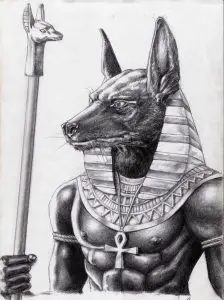Egyptian God Anubis, also called Anpu, ancient Egyptian god of the dead, represented by a jackal or the figure of a man with the head of a jackal. In the Early Dynastic period and the Old Kingdom, he enjoyed a preeminent (though not exclusive) position as lord of the dead, but he was later overshadowed by Osiris.
Stories of Egyptian God Anubis

In some stories, Anubis is the son of Ra and Nephthys, or Set and Nephthys (probably due to Set and Anubis having the same totem animal). Some say He set as his mother, and still, others say Bast. This apparent confusion is still another sign of Anubis’ origins in the most ancient of times. He also has a daughter, Kabechet, who helps him in the mummification.
He was the Egyptian god of the underworld who guided the spirits of the dead into the afterlife. It was his job to wake the dead for their final judgment and oversee ‘the weighing of the heart’. This was the method of judgment used to decide if a soul was worthy to enter the underworld.
He oversaw the embalming and mummification process as well as escorting the deceased through the procedures for entering the underworld. He was also the keeper of poisons and medicines. He provided unguents and rare herbs to help Auset aka (Isis), and her twin sister Nephthys with the embalming of Ausar aka Osiris.
When the Osiris worship came to power, Osiris took over many of Anubis’ jobs as caretaker and protector of the dead. As this happened, Anubis became ‘He Who is Before the Divine Booth’, the god of embalming who presided over the funerary rituals. The funerary stm priests would wear a mask of the jackal god during the mummification process, symbolically becoming the god for the rituals.
Anubis then performed the funeral of Osiris, which would be the model for all funerals to come. As he received the mummy into the tomb, he performed the ‘Opening of the Mouth’ ceremony. In the Hall of Maat – Anubis appears on behalf of the deceased. It was Anubis who saw that the beam of the great scale was in the proper position as he supervises the weighing of the heart of a deceased person against the feather of Maat.
The most famous representation of Anubis was the imposing black model found atop a shrine discovered in the tomb of Tutankhamen. Worshipped widely throughout all of Egypt, his cult center was Cynopolis. Anubis is the most enigmatic of the gods of ancient Egypt, a god who was neither what he seemed nor what he should have been.